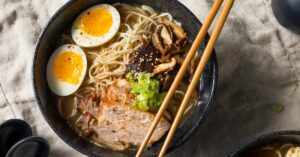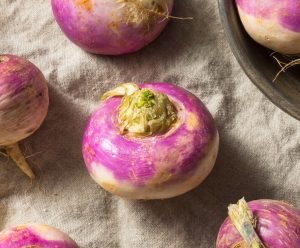Craving an Asian noodle soup but can’t decide on pho vs. ramen? Let’s explore the differences to help you choose.
(Psst. They are both DELICOUS!)

These iconic Asian dishes are the ultimate soul-warming bowls. Each is full of aromatic broths, tender meats, and satisfying noodles.
They hit the spot. Every time.
On the surface, pho and ramen look pretty similar. But some distinct differences make each unique.
Let’s dive into the slurp-worthy world of pho vs. ramen. Noodle novice or soup enthusiast, you’ll learn everything you need to know.
Pho vs. Ramen (What’s the Difference?)
Pho and ramen are beloved Asian dishes full of culture and tradition. But make no mistake, these are not the same noodle soup.
Here are the key differences to tell them apart:
- Origins. Pho hails from Vietnam. Ramen was born in China and introduced to Japan, where it became a staple.
- Broth. Neither would be proper without the correct broth.
- Pho features a beef-based broth packed with spices. Star anise is a crucial ingredient.
- Ramen has a fattier umami-rich broth. Typically, it’s pork-based with miso and soy sauce.
- Noodles. Another tail-tale difference is the noodles.
- Pho calls for slippery rice noodles.
- Yellow, chewy wheat-based noodles are a ramen must.
- Toppings. You can’t have either without the toppings!
- Pho is all about fresh ingredients. Bean sprouts, scallions, basil, lime, and jalapenos are some. Beef is also the primary meat.
- Ramen ramps up on the umami. You’ll find toppings like mushrooms, nori, soft-boiled eggs, lotus root, pork, and fish cakes.

What Is Pho?
Pho is a street food favorite in Vietnam. Most consider it the national dish.
It’s a type of noodle soup born in the 19th century during French colonialism.
Key components include rice noodles, thin-sliced beef, fresh toppings, and a clear anise-infused broth.
Creating the base is no quick task. Oxtail, beef bones, ginger, and charred onions must simmer for hours. But it is worth it!
Whole spices like black cardamom, coriander seed, and star anise add complexity.
Then come toppings like bean sprouts, fresh herbs, chili oil, scallions, and fish sauce.
The cuts of beef can vary. Many times, peopole add thin raw slices and let them cook in the broth.
There are other variations, too. Some use chicken instead of beef. Others skip poultry and red meat for seafood instead.
All are great if you ask me!
Types of Pho
Before you enjoy a bowl of pho, you should know the types.
Here are the two most popular ones to choose from.
- Pho Bac. This is the type of pho you’ll find in northern Vietnam. The broth features light spices. Garnish with green onions and cilantro, plus slices of raw beef.
- Pho Nam. In the south, you’ll find pho nam. It’s more complex than the northern version with a bolder broth. Plus, the toppings are more plentiful.

What Is Ramen?
Authentic ramen is NOT like those store-bought packages you lived on in college. Oh no, it’s so much more than that!
It’s a Japanese-style soup packed with umami. Yellow wheat noodles, savory broth, a soft-boiled egg, and pork are signature ingredients.
Toppings like seaweed, fish cakes, green onions, and corn are popular. Miso and soy sauce are two of the more widely used flavoring agents.
Like pho, the broth of this soup takes time to craft.
Pork or chicken bones, collagen, and fat often simmer for hours. The final product is cloudy, dark, and packed with flavor.
The base depends on the variety, though. Vegetarian versions don’t include meat. Others may use beef bones.
Many think of ramen as a Japanese invention. However, many sources claim it was born in China.
The common belief is that Chinese immigrants brought it to Japan during the 1900s.
As the noodle dish grew popular, it became intertwined with Japanese culture. So much so, we now consider ramen to be a Japanese dish.
Types of Ramen Broth
By popular demand, there are many different versions of ramen broth.
There are many ramen broth varieties- beef, chicken, pork, seafood, or veggie.
Here are the most common types:
- Miso Ramen. As the name suggests, this ramen has miso. This fermented soybean paste infuses the broth with a tangy umami.
- Shio Ramen. Unlike other versions, the only seasoning in the broth is salt. Chicken, fish, seaweed, and veggies are customary toppings.
- Shoyu Ramen. Shoyu is a Japanese-style soy sauce. It makes the brother dark with a big umami kick.
- Chicken and vegetable bases are routine. But sometimes, you can use beef or seafood.
- Tonkotsu Ramen or Hakata Ramen. This style requires cooking pork bones, collagen, and fat for hours. The result is a thick and creamy base with a robust pork taste.
- Karē (Curry) Ramen. Newer to the scene is karē. Curry paste adds a punch of flavor to a pork base.
- Enjoy thick curly noodles, seaweed, and sliced pork with this broth.

Pho vs. Ramen (Which Is Better?)
Deciding between pho and ramen can lead any Asian soup lover into a dilemma. Each of these popular bowls is worthy of your spoon.
But is pho better, or is ramen superior? It’s an unending debate that depends on you.
Pho is the healthier option of the two. The bone broth is full of minerals and spices. The toppings include a wide range of fresh ingredients.
Plus, it’s also gluten-free.
But nailing the broth of pho is no easy task. You have to use the right balance of spices. And locating oxtail can be tricky.
Ramen, however, is dripping with comfort. The fatty pork broth, rich umami taste, savory toppings, and salty seaweed are cozy.
Like pho, the broth takes quite some time to make authentic. However, taking shortcuts is a bit more forgiving.
Really, neither one is better than the other. It’s just a matter of your diet, mood, and taste preference.
I say, let a taste test decide!
Try a bowl side by side and see what you think. I think you’ll agree there’s a time and a place for each soup.










